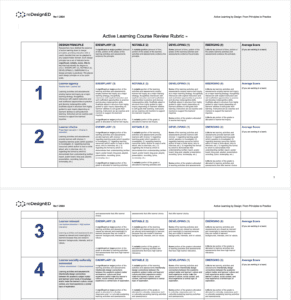Refining active learning design principles through design-based research
What is it about?
This study published in the journal for Active Learning in Higher Education (2022) grappled with how to better define active learning so that the design principles can guide the development of more powerful learning experiences for students. As part of its design intervention, a team of instructional designers iteratively developed a rubric, and over a three-year-span conducted course reviews of undergraduate courses at all levels that resulted in active learning scores which made active learning measurable.
Courses in the low active learning range underemphasized learning sciences research about the constructive, situated, self-regulated, and collaborative nature of learning. Courses in the medium active learning range (the majority of them) showed representation of some of the design principles but did not create authentic contexts for learning. Courses in the high active learning range followed scientific findings that learning is constructed by the learner through interactions with others and the world.
The study (Reilly, 2020) also directly asked students about what made learning meaningful and coded their open-ended responses back to the design principles. As such, the design principles derived from this study are verified by 1000 learner testimonies.
Why is it important?
The current state of education is confronted with multiple significant challenges simultaneously: 1) how to navigate post-pandemic recovery and address the learning losses that have widened an already long-standing achievement gap, 2) how to leverage AI for learning, 3) how to deliver a learning design that fosters enduring human-centered skills so that all students can thrive and take advantage of what the future has to offer; 4) how to teach learners more than narrow disciplinary knowledge to foster a mindset better prepared to succeed in increasingly volatile, uncertain, complex, and ambiguous (VUCA) modern world, 5) how to counter the lack of engagement, motivation, absenteeism, and even drop-out rates by which students are letting us know that they are not finding school relevant and worth attending.
Active learning is at the nexus of transforming today’s education system. A group of more than 400 researchers offering advice about education during this time of post-pandemic recovery have urged schools to provide the most personalized and engaging instruction possible by prioritizing authentic, culturally-responsive learning experiences.
The refined design principles resulting from this study: 1) learner agency, 2) learner choice, 3) learner-relevant, 4) learner socially-culturally connected, 5) learner self-expression, 7) learner creativity, 8) learner attitudes and values address these needs.
Perspectives
While authentic learning experiences are at the nexus of so many pressing education issues, they also face challenges to be implemented at scale. A foremost reason is that authentic learning experiences require a paradigm shift from teaching to learning. They require creativity in order to customize learning experiences to the local context and culture. They require time and instructional design support to design, develop, and implement. Precisely because they are authentic, they resist automation. The current challenges present an unprecedented impetus for change. We launched reDesignED to support the field of education in this important transformation.

Care to listen?
We have created an audio overview of the study with the help of NotebookLM: Refining active learning design principles through design-based research (12:17)
